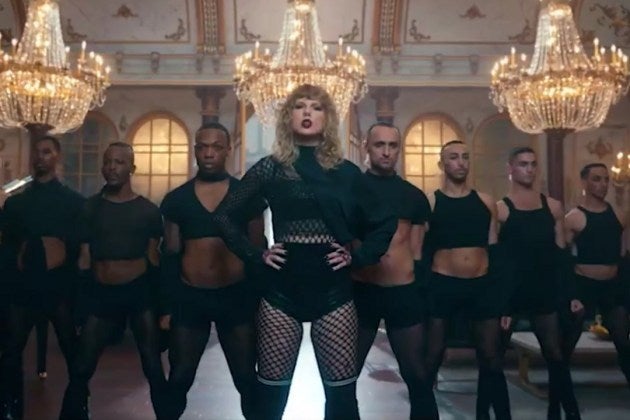When Taylor Swift posted a teaser clip from her new music video for the single “Look What You Made Me Do,” she got instantly and extensively dragged for a particular image’s close similarity to Beyoncé’s “Formation” and Lemonade aesthetic. The video’s director, Jospeh Kahn, denied any connection.

The full video debuted as an exclusive segment during the 2017 MTV VMAs (Swift’s favorite stage for pettiness and the scene of the original “crime” against her — Kanye’s 2009 interruption that in all fairness did actually “make that b**** famous”). It’s true the visual from the teaser invokes moments in Beyoncé’s “Formation” (as does the sonic aspect of “Look What You Made Me Do”), but in larger context, there’s something else going on.
The video as a whole is an amalgamation of ripoffs: Michael Jackson, Lady Gaga, Sia, Nicki Minaj, and Beyoncé videos all seem to be reference points, along with some of Swift’s own. (And those are just the ones I caught on first viewing — I don’t want to watch that thing again.) Apropos of nothing, there’s also a particularly cheap shot at Katy Perry during a car crash scene where Swift’s hair is arranged to look like Perry’s new short cut while Swift grasps a Grammy Award — something Katy Perry has yet to win.
“Credit will be heaped on Swift for this “brave, bold” artistic move, but it’s still just another copy. Beyoncé did all this over four years ago”
Swift and Kahn may have been using references to other videos as a commentary on the notion of celebrity, publicity, reputation in general. But hidden underneath the collaged cultural references is the fact that Swift actually copied the entire concept and execution of another unlikely Beyoncé production, one that had much bigger implications beyond just music. I’m talking about the Pepsi commercial that prefaced her performance at the 2013 Superbowl and the release of Life Is But A Dream shortly thereafter.
That simple commercial (though nothing Beyoncé does is ever truly simple) was about disassociating a public performer self from a private persona. Becoming Beyoncé the artist and Beyoncé the person simultaneously. While she’d always been hesitant to speak about her private life in public, 2013 marked an even more extreme shift. She quit giving interviews. She spoke to the public only through the visual medium of Instragram. Since 2013, that intense privacy she created hasn’t eroded. She drew a heavy line as a survival strategy.
She hints at this strategy in Life Is But A Dream with a sly reference to Nina Simone. Citing that fans didn’t question what Simone’s daughter was wearing on any given day and that they just enjoyed the music. Beyoncé describes the way the culture of celebrity has changed over the past few decades and the viewer sees Beyoncé longing for that same ability to be private while still making affecting important art. The reference to Simone takes on even more urgent layers now that the public knows the extent of her mental health struggles.
Beyoncé’s Pepsi commercial showed various iconic moments from past videos in mirrors while Beyoncé herself danced the choreography in front of them. It was a kind of daydream motif where she was reflected back at herself in multiple, but in ways that were frozen in time. This is also the first time the public heard a snippet of the song “Grown Woman” — a song where Beyoncé asserts she “can do whatever [she] wants” (and she has certainly proven that she can). At the end of the commercial, the mirrors shatter at Beyoncé’s direction; shards fly and Beyoncé is born anew. A new Beyoncé is born. This one, coupled with her allusions in Life Is But A Dream, has a different relationship to publicity and privacy. She will not be as accessible to the public as she may have been in the past. This new strategy culminated in the earth-stopping surprise release of BEYONCÉ on December 13, 2013. While marketing and business moves came out of the strategy, the division itself was about self-preservation.
At the end of Swift’s music video, various versions of her past selves stand in front of an airplane and argue with one another. We also learn that the “old Taylor can’t come to phone right now” because “she’s dead.” Will the real Taylor Swift please stand up? She can’t because there is no true Taylor Swift behind the costumes. There’s no central Taylor Swift as protagonist, like there is a central Beyoncé in the commercial; only more derivatives, more artifice. She attempts to position this realization as an artistic coming of age, but it’s really just her refusing to take responsibility after her true colors were exposed. In fact, the last Taylor we see returns us to the VMAs in 2009: she’s holding her moon man trophy and asking to be excluded from a narrative that she once again created.
And remember the title: “Look What You Made Me Do.” Look what we made her do. She’s blaming us. She’s blaming the fact that we saw behind the curtain, that we found out about her lies and manipulation, as the end result of a hungry public; not because she’s ever done anything wrong. Celebrity culture today does create a hungry public, but that excuse is a disingenuous deflection. The subtext is: “you made me come clean because I was caught and I had no other choice.” It reads as a threat.
I have no doubt pretentious artistic credit will be heaped on Swift for this “brave, bold” artistic move, but it’s still just another copy. Beyoncé did all this over four years ago and she did it from a place of survival and authenticity. To have an actual life in addition to being “Beyoncé,” she had to draw strict boundaries. And not only with the public, but with people in her private life. Swift is appropriating that same strategy, but in a curious reverse, to further her manipulative inauthenticity. She’s erasing the lines of previously understood boundaries to signal that all bets are off. What is supposed to be self-deprecating awareness of her past is actually a threat to the audience.
In Beyoncé’s commercial, her past moments and achievements were celebrated, but she was lovingly shutting a particular door to the public. Swift is throwing open every door in the house and threatening us with what else might be lurking in the dark. She’s weaponizing her reputation (which is that of doe-eyed perpetually victimized white woman) and holding the world hostage. She’s weaponizing her white womanhood, as she’s been doing since 2009, and attempting to co-opt and subvert the strategy of a black woman (Beyoncé) for her own gain. Don’t fall for it. Taylor Swift has attempted to keep us all trapped in 2009 for long enough. If she’s unlocking and opening doors, it’s time we run. Like Beyoncé says in the commercial that Swift clearly didn’t study before she ripped it off: “Embrace your past. But live for now.”
